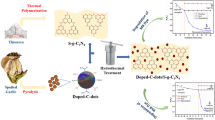Abstract
In this study, magnetically separable Fe3O4-SiO2-mesoTiO2 nanocomposite has been synthesized for photodegradation of Methylene Blue (MB) and Rhodamine B (RhB) cationic dyes which have complex aromatic structures and are difficult to degrade into harmless products. By XRD analysis, it was determined that the magnetite phase of Fe3O4 was protected after coating with SiO2 interlayer and mesoTiO2 shell, and the anatase phase of TiO2 was formed. According to the N2-adsorption/desorption and VSM results, Fe3O4-SiO2-mesoTiO2 nanocomposite has a surface area of 197.8 m2/g, pore volume of 0.34 cm3/g and a pore size of 3.4 nm and has 3.8 emu/g saturation magnetization and negligible remnant magnetization and coercivity, which indicates its mesoporous and superparamagnetic character. The adsorption ability of RhB (16.86%) is lower than MB (23.32%), nevertheless, the photodegradation activity of RhB (99.06%) is higher than that of MB (97.52%). Photodegradation kinetics follows the pseudo-first order and the rate constants of photocatalytic reactions were calculated as 0.0422 and 0.0719 min−1 for MB and RhB, respectively. While the lower adsorption feature of RhB was resulted from steric hindrance, the higher photodegradation rate was explained by more radical scavenging effect. MB prefers to face the photocatalyst surface, whereas RhB prefers to focus on the aqueous phase, and based on scavenge results, RhB is more likely to encounter photoactive species (H2O2, h+ and ·O2−) than that of MB with ·O2− being the dominant active species. The synthesized Fe3O4-SiO2-mesoTiO2 photocatalyst could be reused three times with negligible photocatalytic loss in the photodegradation of both dyes.







Similar content being viewed by others
Data availability
Not applicable.
References
Ahmed SN, Haider W (2018) Nanotechnology 29:342001
Hitam CNC, Jalil AA (2020) J Environ Manage 258:110050
Su G, Liu L, Zhang L, Liu X, Xue J, Tang A (2021) Environ Sci Pollut Res 28:50286–50301
Akpan UG, Hameed BH (2009) J Hazard Mater 170:520–529
Ma J, Sun N, Wang C, Xue J, Qiang L (2018) J Alloys Compd 743:456–463
Nguyen CH, Juang RS (2019) J Taiwan Inst Chem Eng 99:166–179
Wang C, Li Q, Wang RD (2004) Mater Lett 58:1424–1426
Yuan Q, Li N, Geng W, Chi Y, Li X (2012) Mater Res Bull 47:2396–2402
Shibata H, Ogura T, Mukai T, Ohkubo T, Sakai H, Abe M (2005) J Am Chem Soc 127:16396–16397
Teng Z, Su X, Chen G, Tian C, Li H, Ai L, Lu G (2012) Colloids Surf A Physicochem Eng Asp 402:60–65
Huber DL (2005) Small 1:482–501
Akbarzadeh A, Samiei M, Davaran S (2012) Nanoscale Res Lett 7:144
Massart R (1981) IEEE Trans Magn 17:1247–1248
Lewandowski D, Cegłowski M, Smoluch M, Reszke E, Silberring J, Schroeder G (2017) Microporous Mesoporous Mater 240:80–90
Jabbar ZH, Ebrahim SE (2021) Environ Nanotechnol Monit Manag 16:100554
Hosseini N, Toosi MR (2019) Sep Sci Technol 54:1697–1709
Conceição DS, Graça CAL, Ferreira DP, Ferraria AM, Fonseca IM, Botelho do Rego AM, Teixeira ACSC, Vieira Ferreira LF (2017) Microporous Mesoporous Mater 253:203–214
Tu J, Ding M, Wang T, Ma L, Xu Y, Kang S, Zhang G (2017) Energy Procedia 105:82–87
Renuka NK, Praveen AK, Aravindakshan KK (2013) Mater Lett 91:118–120
Nicola R, Costişor O, Muntean SG, Nistor MA, Putz AM, Ianăşi C, Lazău R, Almásy L, Săcărescu L (2020) J Porous Mater 27:413–428
Rabbani M, Seghatoleslami ZS, Rahimi R (2017) J Mol Struct 1146:113–118
Yu JX, Li BH, Sun XM, Jun Y, Chi RA (2009) Biochem Eng J 45:145–151
Luque PA, Garrafa-Gálvez HE, Nava O, Olivas A, Martinez-Rosas ME, Vilchis-Nestor AR, Villegas-Fuentes A, Chinchillas-Chinchillas MJ (2021) Ceram Int 47:23861–23874
Konstantinou IK, Albanis TA (2004) Appl Catal B Environ 49:1–14
Lente G (2015) Deterministic kinetics in chemistry and systems biology: the dynamics of complex reaction networks. Springer, New York
Lente G (2018) Curr Opin Chem Eng 21:76–83
Abdel-Aziz R, Ahmed MA, Abdel-Messih MF (2020) J Photochem Photobiol A Chem 389:112245
Jabbar ZH, Ebrahim SE (2021) Opt Mater 122:111818
Ge B, Han L, Gao B, Zhang T, Li X, Zhu X, Pu X, Li W (2019) Sep Sci Technol 54:962–969
Zhao G, Zou J, Li C, Yu J, Jiang X, Zheng Y, Hu W, Jiao F (2018) J Mater Sci Mater Electron 29:7002–7014
Trandafilović LV, Jovanović DJ, Zhang X, Ptasińska S, Dramićanin MD (2017) Appl Catal B Environ 203:740–752
Humayun M, Raziq F, Khan A, Luo W (2018) Green Chem Lett Rev 11:86–102
Funding
This work was supported by The Commission of Scientific Research Projects of Bursa Uludag University, Project number: FGA-2021-543.
Author information
Authors and Affiliations
Contributions
Experimental studies including the synthesis and photocatalysis parts were performed by authors BE and SS. Authors BE, SE and RMÖ have contributed in catalyst characterization. The first draft of the manuscript was written through contributions of all authors and they have given approval to the final manuscript.
Corresponding author
Ethics declarations
Competing interests
The authors declare that they have no known competing financial interests or personal relationships that could have appeared to influence the work reported in this paper.
Ethical approval
Not applicable.
Additional information
Publisher's Note
Springer Nature remains neutral with regard to jurisdictional claims in published maps and institutional affiliations.
Rights and permissions
Springer Nature or its licensor (e.g. a society or other partner) holds exclusive rights to this article under a publishing agreement with the author(s) or other rightsholder(s); author self-archiving of the accepted manuscript version of this article is solely governed by the terms of such publishing agreement and applicable law.
About this article
Cite this article
Erdem, B., Sevinç, S., Erdem, S. et al. Comparative influence of adsorption assisted magnetic mesoporous TiO2 photocatalyst for the removal of methylene blue and rhodamine B. Reac Kinet Mech Cat 136, 1049–1065 (2023). https://doi.org/10.1007/s11144-023-02397-w
Received:
Accepted:
Published:
Issue Date:
DOI: https://doi.org/10.1007/s11144-023-02397-w




